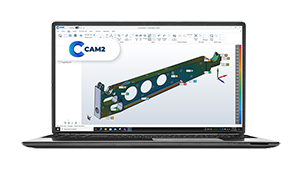Creating a GDT Line Profile Call-out in CAM2
Overview
How to apply a GDT line profile call-out to a feature.
Preparation
- Alignment to a CAD model is required.
- Line Profile can be applied to:
- Cross Section Scan (LLP or Hard Probe)
- Polyline (Hard Probe)
- Measure the required feature
Creating the GDT Call-out
- Select the GDT tab
- Highlight the required feature in the Feature panel
- From the ribbon select
 Profile of a Line
Profile of a Line
The GDT panel will open in the lower LH corner of the UI

Note: If the GDT icon is ‘greyed-out’ this details that the selected feature does not support this call-out.
- Within the GDT panel:
- Click into the tolerance, and enter the required value
- Profile of a line does not support datum callouts and is calculated based upon the active alignment.

The call-out will be calculated and the result will be shown in the GDT label displayed in the 3D viewer.

Copying GDT Call-outs to Other features
This allows multiple features of the same type to have the same call-out applied
- Apply the call-out to the first feature
- Highlight the first feature
- Right click and select Copy Tolerances
- Multi-select other features
- Right click and select Paste Tolerances
- Message ‘Do you also want to paste the GDT tolerances?’, select Yes
The GDT call-out will be applied to the selected features, and the GDT label will be displayed.
How it’s Calculated
Profile of a Line is a 2D geometric tolerance that controls how much a polyline, or cross section scan, can deviate from the true profile. It represents the smallest tolerance zone conforming to the nominal curve contour that will hold the entire measured surface.
When applied to a surface, the entire measured cross section must fall within the tolerance zone, therefore all points on the surface must remain within this zone to be deemed as acceptable.
CAM2 can report Surface Profile as per ISO 1660 or ASME Y14.5. The option which to set as default can be found in: Preferences > Measurement > Other tab > Profile calculation method

Nominal Deviation: Calculated as per ISO 1660
The tolerance zone is restricted by two envelope curves of each circle with diameter t, and the centres of these circles are positioned on a line that has the theoretically accurate geometrical configuration.

CAM2 displays the MinError and MaxError values and only the greatest deviation is used in this calculation within in the Feature Information.

Absolute Error: Calculated as per ASME y14.5
For profile of a surface, the tolerance value represents the distance between two boundaries equally or unequally disposed about the true profile or entirely disposed on one side of the profile.

CAM2 displays the MinError and MaxError values used in this calculation within in the Feature Information.

See Also
Keywords:
GD&T, Help Sheet, GDT011

